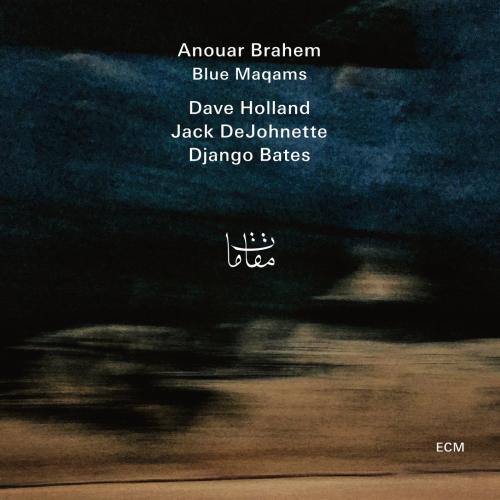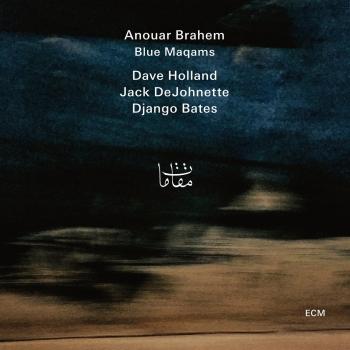
Blue Maqams Anouar Brahem
Album Info
Album Veröffentlichung:
2017
HRA-Veröffentlichung:
13.10.2017
Das Album enthält Albumcover Booklet (PDF)
Entschuldigen Sie bitte!
Sehr geehrter HIGHRESAUDIO Besucher,
leider kann das Album zurzeit aufgrund von Länder- und Lizenzbeschränkungen nicht gekauft werden oder uns liegt der offizielle Veröffentlichungstermin für Ihr Land noch nicht vor. Wir aktualisieren unsere Veröffentlichungstermine ein- bis zweimal die Woche. Bitte schauen Sie ab und zu mal wieder rein.
Wir empfehlen Ihnen das Album auf Ihre Merkliste zu setzen.
Wir bedanken uns für Ihr Verständnis und Ihre Geduld.
Ihr, HIGHRESAUDIO
- 1 Opening Day 07:01
- 2 La nuit 10:29
- 3 Blue Maqams 08:42
- 4 Bahia 08:46
- 5 La passante 04:06
- 6 Bom Dia Rio 09:24
- 7 Persepolis's Mirage 08:07
- 8 The Recovered Road To Al-Sham 09:27
- 9 Unexpected Outcome 10:59
Info zu Blue Maqams
Drei Meister ihrer Instrumente musizieren auf diesem langerwarteten Album mit dem tunesischen Oud-Virtuosen Anouar Brahem. Für Brahem und Dave Holland stellt die im Mai 2017 in New York eingespielte Aufnahme eine Wiederbegegnung dar: Sie spielten erstmals für das Album Thimar mit John Surman zusammen. Brahem und Jack DeJohnette wiederum treffen sich auf Blue Maqams zum ersten Mal für eine Aufnahme. Holland und DeJohnette allerdings waren in den letzten Jahrzehnten häufig Partner, seit ihrem Zusammentreffen bei Miles Davis ist ihr Zusammenspiel legendär. Auch der britische Pianist Django Bates fügt sich stimmig in diese Gruppe.
Für Anouar Brahem ist es der Prozess selbst, der ihm die Richtung vorgibt. Er stellt sich die Frage nach der Besetzung erst, während die Musik sich bereits herauszubilden beginnt: „Ich begann wie meistens“, schreibt er in seinem Begleittext zu Blue Maqams, „indem ich die Ideen erstmal kommen ließ, ohne eine bestimmte Tendenz in die eine oder andere Richtung hinsichtlich Stil, Form und Instrumentierung.“ Er arbeitete parallel an verschiedenen Skizzen, „und was sich dabei zuerst abzeichnete und dann wirklich konkreter wurde, war, dass ich einmal mehr die Klänge der Oud und des Klaviers zusammenbringen wollte. Doch dann entstand bald mein Wunsch, diese mit einer eingespielten Jazz-Rhythmusgruppe zu verbinden.“
Obwohl er nie den Ehrgeiz hegte, auch ein Jazzmusiker zu sein, hat Anouar schon seit längerer Zeit eine Verwandtschaft mit den Protagonisten dieses Genres empfunden: „Schon als junger Musikstudent begann ich in meiner Heimatstadt Tunis Jazz zu hören. Zu der Zeit widmete ich mich mit Hingabe der traditionellen arabischen Musik, die ich bei dem großen Meister Ali Sriti studieren durfte. Gleichzeitig war ich aber auch voller Neugier auf andere musikalische Ausdrucksformen. Die Ästhetik des Jazz ist eine ganz andere als die der arabischen Musik, aber ich fühlte mich davon angesprochen, weil sie mir eine andere Welt eröffnete, eine, der ich mich ebenfalls nahe fühlte. Zweifellos gibt es eine gewisse Spontaneität in der arabischen Musik, nämlich eine Art zu spielen, die es den Musikern erlaubt, sich einige Freiheiten gegenüber dem Notentext zu gestatten; und das spiegelt vielleicht auch das, was im Jazz passiert...“
Brahem fing in den 1980er Jahren an mit Jazzmusikern zu spielen, erste Aufnahmen davon entstanden in der folgenden Dekade. Das Album Madar brachte ihn 1992 mit dem Saxophonisten Jan Garbarek und dem Tabla-Spieler Shaukat Hussain zusammen, während er auf Khomsa (1994) mit François Couturier, Palle Danielsson und Jon Christensen ursprünglich für Film und Theater geschriebene Stücke neu einspielte. Thimar (1997) mit Dave Holland und John Surman markierte einen Aufbruch in andere Formen der Improvisation, bei dem diese drei Musiker eine gemeinsame Sprache fanden. Blue Maqams entwickelt nun diese Idee weiter. Das „Maqams“ im Titel bezieht sich auf das modale System in der arabischen Musik, das hier von den Musikern gewissermaßen „kind of blue“ gefärbt wird.
Es war nicht einfach, den Pianisten für dieses Projekt auszuwählen. „Über mehrere Monate hörte ich mir eine Vielzahl von Pianisten an und hatte viele lange Diskussionen mit Manfred Eicher hinsichtlich der Eigenschaften die der Pianist für diese Aufnahme haben sollte. Schließlich spielte er mir eines Tages Musik vor, die er gerade mit Django Bates eingespielt hatte. Ich war sehr beeindruckt von Djangos Anschlag, seinem Timbre und rhythmischem Spiel. Im New Yorker Avatar Studio entdeckte ich dann noch eine Reihe weiterer Qualitäten bei Django. Es gelingen ihm auf dieser Aufnahme einige ganz besondere Momente, die die Stücke sehr bereichern.“
Freiheit und Notentreue in die richtige Balance zu bringen, sieht Brahem als entscheidend an: „Ich möchte, dass jedes Stück eine eigene Identität durch die auskomponierten Passagen behält. Die Rolle des Musikers ist es, sich innerhalb des Rahmens eines jeden Stückes so auszudrücken, dass seine Eigenheit bewahrt wird. Ein entscheidender Teil unseres Zusammenspiels dreht sich genau um diesen Aspekt – gemeinsam die richtige Balance aus aufgeschriebener und improvisierter Musik zu finden. Denn selbst in komponierten Stücken oder in Passagen, in denen vielleicht weniger Raum zur Interpretation bleibt, möchte ich, dass die Musik klingt, als bewege sie sich vorwärts in einem stetigen Fluss.“
Blue Maqams wurde in den New Yorker Avatar Studios aufgenommen und von Manfred Eicher produziert.
Anouar Brahem, Oud
Django Bates, Klavier
Dave Holland, Kontrabass
Jack DeJohnette, Schlagzeug
Anouar Brahem
was born in 20 th October 1957 in Halfaouine in the Medina of Tunis. Encouraged by his father, an engraver and printer, but also a music lover, Brahem began his studies of the oud, the lute of Arab world, at the age of 10 at the Tunis National Conservatory of Music, where his principal teacher was the oud master Ali Sriti. An exeptional student, by the age of 15 Brahem was playing regularly with local orchestras. At 18 he decided to devote himself entirely to music. For four consecutive years Ali Sriti received him at home every day and continued to transmit to him the modes, subtleties and secrets of Arab classical music through the traditional master / disciple relationship.
Little by little Brahem began to broaden his field of listening to include other musical expressions, from around the Mediterranean and from Iran and India... then jazz began to command his attention. 'I enjoyed the change of environment,' he says' and discovered the close links that exist between all these musics'.
Brahem increasingly distanced himself from an environment largely dominated by entertainment music. He wanted more than to perform at weddings or to join one of the many existing ensembles which he considered anachronistic and where the oud was usually no more than an accompanying instrument for singers. A deepfelt conviction led him to give first place to this preferred instrument of Arab music and to offer the Tunisian public instrumental and oud solo concerts. He began writing his own compositions and gave a series of solo concerts in various cultural venues. He also issued a self-produced cassette, on which he was accompanied by percussionist Lassaad Hosni.
A loyal public of connoisseurs gradually rallied around him and the Tunisian press gave enthusiastic support. Reviewing one of Brahem's first performances, critic Hatem Touil wrote: 'this talented young player has succeed not only in overwhelming the audience but also in giving non -vocal music in Tunisia its claim to nobolity while at the same time restoring the fortunes of the lute. Indeed, has a lutist produced such pure sounds or concretised with such power and conviction, the universality of musical experience'
In 1981, the urge to seek new experiences became ever stronger and his departure for Paris, that most cosmopolitan of cities, enabled him to meet musicians from very different genres. He remained for four years, composing extensively, notably for Tunisian cinema and theatre. He collaborated with Maurice Béjart for his ballet 'Thalassa Mare Nostrum' and with Gabriel Yared as lutist for Costa Gavras’ film 'Hanna K.'.
In 1985 he returned to Tunis and an invitation to perform at the Carthage festival provided him with the opportunity of bringing together, for 'Liqua 85' , outstanding figures of Tunisian and Turkish music and French jazz. These included Abdelwaheb Berbech, the Erköse brothers, François Jeanneau, Jean-Paul Celea, François Couturier and others. The success of the project earned Brahem Tunisia's Grand National Prize for Music.
In 1987, he was appointed director of the Musical Ensemble of the City of Tunis (EMVT). Instead of keeping the large existing orchestra, he broke it up into formations of a variable size, giving it new orientations: one year in the direction of new creations and the next more towards traditional music. The main productions were 'Leïlatou Tayer' (1988) and 'El Hizam El Dhahbi' (1989) in line with his early instrumental works and following the main axis of his research. In these compositions, he remained essentially within the traditional modal space, although he transformed its references and upset its heirarchy. Following a natural disposition towards osmosis, which has absorbed the Mediterranean, African and Far-Eastern heritages, he also touched from time to time upon other musical expressions: European music, jazz and other forms.
With 'Rabeb' (1989) and 'Andalousiat' (1990), Anouar Brahem returned to classical Arab music. Despite the rich heritage transmitted by Ali Sriti and the fact that this music constitued the core of his training, he had in fact, never performed it in public. With this 'return' he wished to contribute to the urgent rehabilitation of this music. He put together a small ensemble, a 'takht', the original form of the traditional orchestra, where each instrumentalist plays as both a soloist and as an improviser. Brahem believes this is the only means of restoring the spirit, the subtlety of the variations and the intimacy of this chamber music. He called upon the best Tunisian musicians, such as Béchir Selmi and Taoufik Zghonda, and undertook thorough research work on ancient manuiscripts with strict care paid to transparency, nuances and details. For more information visit: http://www.anouarbrahem.com
Booklet für Blue Maqams














